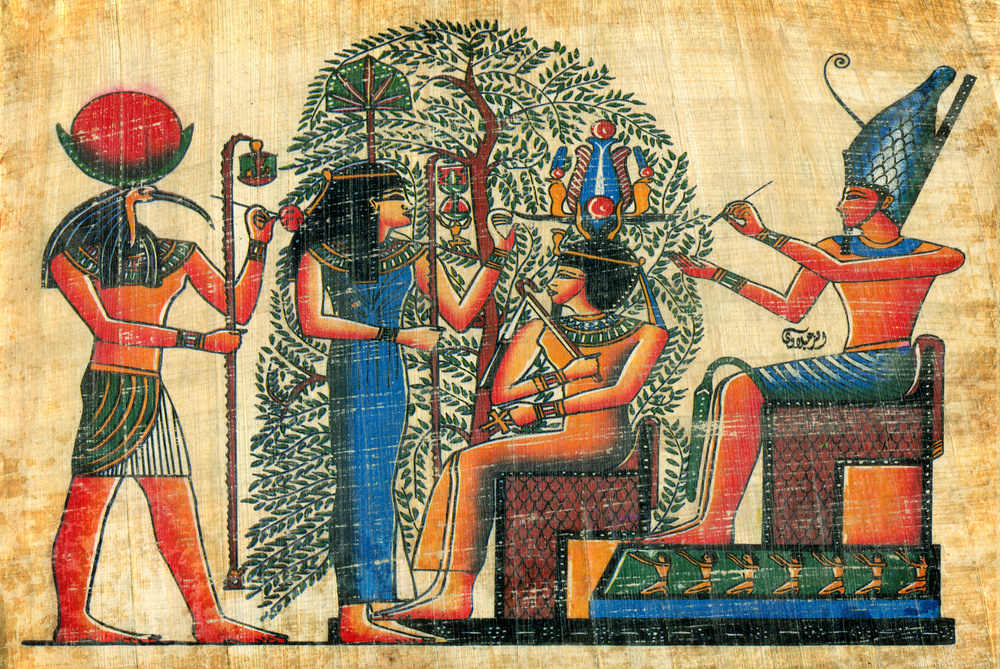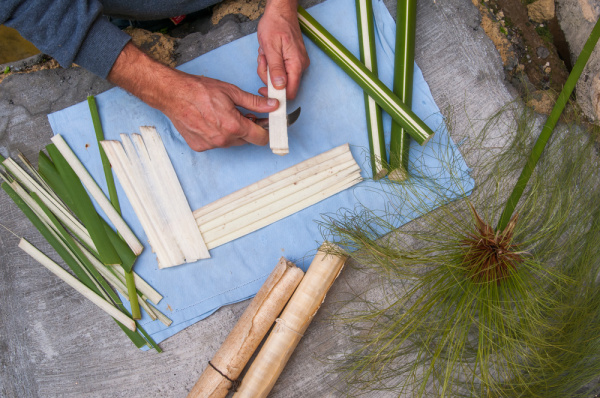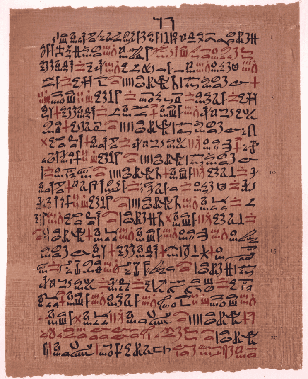Papyrus: the ‘paper’ of Ancient Egypt
Papyrus: the ‘paper’ of Ancient Egypt
Papyrus: the ‘paper’ of Ancient Egypt
-
Hannah
-
Hannah

Back before Johannes Gutenberg invented the printing press in the 15th century, before the Romans created parchment codices in the 1st century, before anyone had even conceived of binding paper between covers, there was… papyrus.
The Cyperus papyrus grew abundantly on the banks of the Nile in ancient times, and the people used every part of the plant in daily life; it was used to make items as diverse as baskets and medicines, boats and shoes. And, of course, it was used to make a very important and very durable type of paper.
This thick paper, which is known today simply as papyrus, was made from the stem of the Cyperus papyrus following a simple process:
- Strip off the outer rind.
- Cut the pith into strips.
- Line strips up, side by side, to form a sheet.
- Layer on more strips running perpendicular to the first ones.
- Using a hammer, merge the layers together.
- Wet the paper (which creates a glue-like quality) and then leave to dry in the sun.
In this way, papyrus was relatively easy to make. Rather than use multiple pages for a text or attempt to fold the unpliable papyrus, the Egyptians would glue sheets together to make scrolls.

We know that papyrus was made all the way back in the third millennium BC: archaeologists have recovered a papyrus from the reign of Khufu (4th Dynasty; 2589–2566 BC). Due to the dry climate in Egypt, some scrolls and fragments of papyrus have survived the many years since in remarkable condition. Here are some famous papyri from Ancient Egypt that have been discovered in modern times:
- The Wadi al-Jarf Papyri (26th century BC) tell us about the construction of the Great Pyramid of Khufu.
- The Papyrus of Ani (c. 1250 BC) is a record of the Book of the Dead (usually inscribed on the walls of tombs).

Scene from the Papyrus of Ani
- The Rhind Mathematical Papyrus (c. 1550 BC) gives us an understanding of how the Ancient Egyptians approached maths.
- The Westcar Papyrus (18th–16th century BC) is a collection of five folk tales.
- The Edwin Smith Papyrus (c. 1600 BC) shows us how the Egyptians performed surgery.
- The Ebers Papyrus (1500 BC) is a detailed record of Ancient Egyptian medicine

Asthma remedy from the Ebers Papyrus
- The Turin Royal Canon (reign of Ramesses II; 1279–1213 BC) is a record of the pharaohs of Egypt.
- The Turin Papyrus Map (1150 BC) is the oldest known map of the ancient world.
- The Turin Erotic Papyrus (1150 BC) is an erotic painting. I describe it as follows in Song of the Nile:
‘People think that the Kama Sutra was the first sex manual of its kind, but there is a famous Ancient Egyptian papyrus painting discovered at Deir el-Medina in the early nineteenth century, created during the Ramses period, that pre-dates it.’ Phares grinned mischievously. ‘It portrays in the most erotic way what went on between the bedsheets in Ancient Egypt.’
Eventually, once the Age of the Pharaohs was at an end, vellum and parchment became popular as ‘paper’; papyrus just wasn’t durable outside of the very dry and hot climate of Egypt. Egyptian people continued to use papyrus for centuries, but they slowly adopted parchment too, and then paper introduced by the Moors.
Nevertheless, Egypt will be forever associated with its papyrus – this creation gifted by the precious Nile which allowed the people to record their stories, their beliefs, their fascinating history.

Song of the Nile: available to buy now
Photo credits: 1) Nella/Shutterstock; 2) Marco Ossino/Shutterstock; 3) public domain/Wikipedia; 4) public domain/Wikipedia.
I brought some paintings on Papyrus from Egypt the one time I was there aboard ship. We were in Hurghada.
I find it hard to resist buying papyrus art!